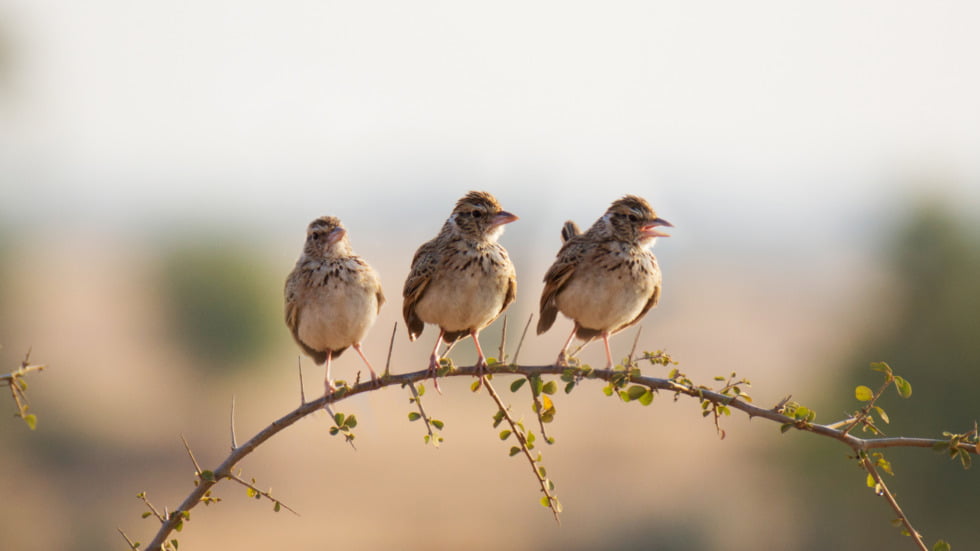
What better place for bird lovers than the Karoo? Wide open spaces, great silence, a vast sky. And thousands of birds breeding in a fair amount of freedom and security. Visitors are few and cautious, and therefore cause little upset to the birds who continue to come and go without much concern about human interference. As a result, bird lovers are able to glimpse many varieties of birdlife, and also enjoy an up-close, intimate view of their daily lives.
The Karoo covers the arid south-western zone of South Africa, and is a diverse region stretching from the Atlantic Ocean in the west to the Orange River in the north-east; a wild, semi-desert covering some fascinating historical, geological, and environmental perspectives.
A region of contrasts and extremes, it is bound by fynbos to the south, grasslands to the east, and deserts to the north. This juxtaposition of biomes and environments has created an incredible array of unique habitats exploited by both plants and animals, many of which have adapted to life at its harshest.
The value of avitourism in the Karoo
Avitourism, or people who travel for the purpose of birdwatching, is one of the fastest growing nature-based tourism activities worldwide. In South Africa alone the market averages around 40,000 people per year. Birdwatchers tend to spend more money compared to other tourists, and as a result many Karoo facilities are specifically tailoring their offerings to meet birdwatchers’ needs.
For birders, the biggest attraction is the endemics – birds found only in the Karoo and nowhere else. Getting up close and personal with these birds is obviously a particular highlight for birdwatchers; bird hides and good vantage points are provided, and often a guide will show you the best places to find and station yourself for good views of sought-after breeds.
Some particular birdwatching favourites
Knowing which species are important to birdwatchers presents a valuable service to visitors.
- Considering it is such a dry region, the Karoo remains rich in bird species. Nearly 300 species live in or make use of the region; nomadic birds will move into areas following high rainfall, such as the Lark-like Bunting, Black-eared Sparrowlark, Grey-backed Sparrowlark, and Stark’s Lark.
- With their unique calls and some attention, they can be readily told apart. Resident species of birds tend to maintain low densities and wait for rainfall events, whereas nomadic species search for rich resource patches scattered in time and space, which means their respective densities will vary temporally and spatially.
- Resident birds are often found close to human habitats. The Familiar Chat, Karoo Scrub Robin, Mountain Wheatear, Cape Sparrow, Pied Starling, Red-eyed Bulbuls, Cape Robin-Chats, Karoo Thrush, and mousebirds all love Karoo garden environments.
- After good rains a wide variety of succulent plants bloom, attracting sunbirds, and in the valleys acacias provide a home for species such as canaries, weavers, Cape White-eye, and Chestnut-vented Tit-babbler; not to mention specials such as Southern Tchagra and Pririt Batis. In addition, Cardinal Woodpecker, Sombre Greenbul, Bar-throated Apalis, African Dusky Flycatcher and Cape Batis have all been recorded, and if lucky, you might catch sight of the rare Booted Eagle.
- In scrub vegetation, Karoo Prinia, Long-billed Crombec, Fairy Flycatcher and Cape Bunting may be found. Higher up the hills where longer walking trails reach into fynbos, the lucky birdwatcher may flush an elusive Hottentot Buttonquail.
- Around farm buildings in particular, Cape Weavers breed in profusion in the spring. Greater Striped Swallows and Rock Martins build their nests under the eaves, and Pied Barbets excavate their nests in fence posts.
- Overhead, in addition to White-necked Ravens, birds of prey include: Jackal Buzzard, African Harrier-Hawk and Rock Kestrel, while at night the hoots of Spotted Eagle Owls may be heard.
- Taking drives or walks to special spots where a variety of birds can be seen, is the way birdwatchers spend their time in the Karoo. Species such as Southern Pale Chanting Goshawk, Karoo Korhaan, Karoo Eremomela and Karoo Chat may be seen.
- Homesteads on farms provide many resources for birds, and as such tend to have higher species richness than the surrounding landscape. As well as supplemental food, there is usually water, trees, shrubs and watered gardens, which provide food and nesting places for birds.
Heuningland: African & Karoo tours to stir the heart and lift the soul
We are proudly South African and have a fervent love of the Great Karoo, its people and its unique vegetation and animals. We are passionate conservationists of nature and would like to share our knowledge acquired through years of travel and touring experience. We are therefore able to offer custom-designed and distinctively different tour options:
- Hiking/camping trails or guided self-driving tours through the ancient landscape of the Karoo.
- Tailor-made safaris to any destination in South Africa, Namibia, Zimbabwe, Zambia, Mozambique, and Botswana.
Find out more at: www.heuningland.com




